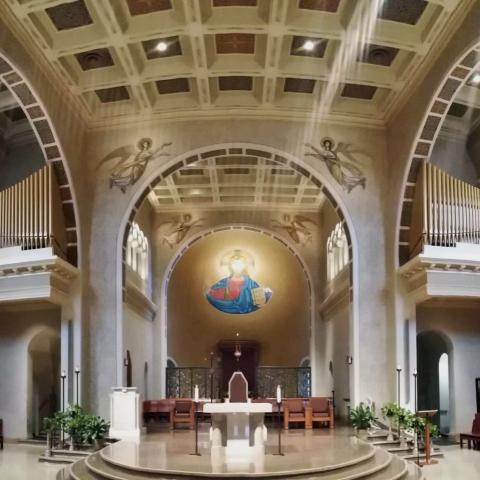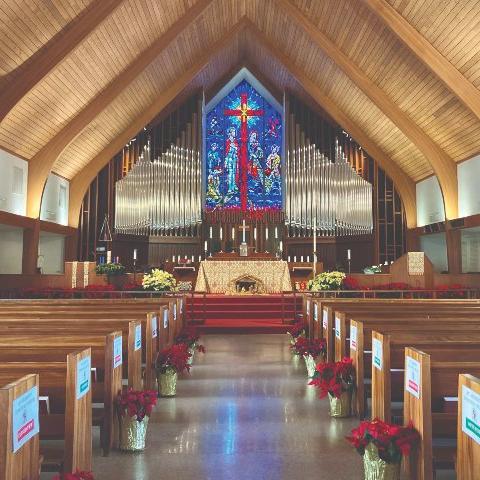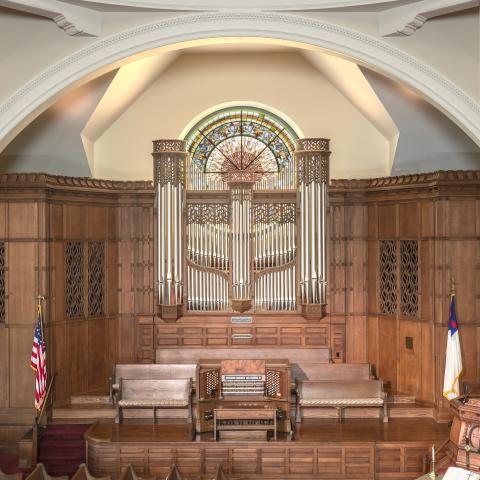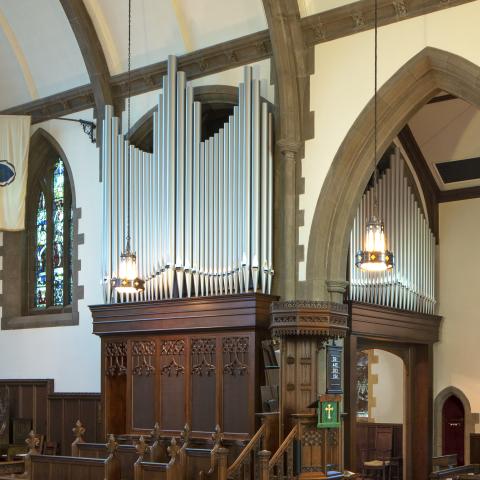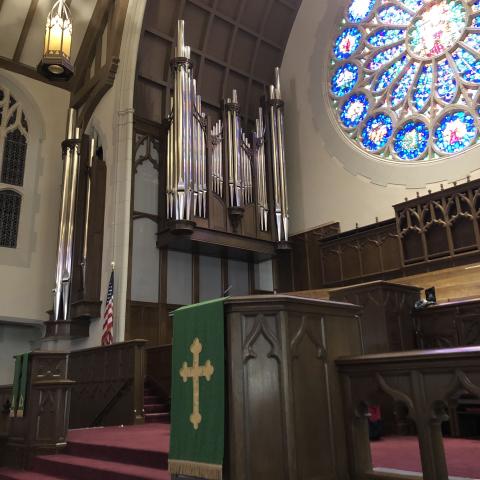Sebastian M. Glück, Opus 24, New York, New York; Setauket Presbyterian Church, Setauket, New York

Vice, virtue, and flexibility
Among the linguistic tics bandied about the organbuilding craft for the better part of a century is “judicious unification,” apologetically implying that the practice is quantifiably evil depending upon the extent of its use and the judgment of the builder. If we dislike the builder, it is dismissed as cheap expediency; if we adore the builder, it is the methodology of a thoughtful and clever artist. Both assessments can be, and have been, accurate. Duplexing (the ability to play a stop from more than one keyboard) and unification (the ability to play a particular stop at more than one pitch) have been in use for more than three hundred years. A century after the cinema organ flourished, many are granting “unit orchestras” absolution as we try to preserve the few that we have yet to destroy, with the expectation that accompanying silent films in church will reinvigorate appreciation for the organ, even if it is not used to play organ music.
In some circles, the conservative traditionalist falls from grace when employing a rank of pipes for more than one musical purpose, although a “pass” is granted if the duplexing or extending is achieved solely with wires, rods, and levers. Regardless of action type, compromise is inevitable when space is rationed. For the staunch purist, the compromise must take the form of a smaller instrument in which each stop serves a single function, eagerly sacrificing variety, color, and scope. The establishment may believe that such a design process is additive, but in truth, pressure is applied to exclude stops from the project. The builder who designs, scales, voices, and finishes a partially unified organ must weigh and assume responsibility for the musical consequences of each compromise.
At Setauket Presbyterian Church, I set out to design an organ that could be played, despite the unification or duplexing of nine of its twenty-five ranks, as a traditionally disposed instrument while avoiding some of the perceived pitfalls of the extension principle: lack of character distinction between the manual sections, “missing note syndrome,” divisional imbalance, and an ineffective Pedal department.
The assignment
The congregation owned a pipe organ built in 1968, to which artificial orchestral voices had been added. The ailing instrument had served adequately for hymnody and life cycle events, but the tonal design did not extend consideration to the performance of the established organ literature. When developing the specifications with consultant David Enlow, we agreed that if the organ could be used to perform the noble repertoire of the past, it would be a fine church organ. No instrument can be loyal to the music of every culture and era, but we were adamant that in addition to the features common to all schools of organbuilding, specific tone colors should be placed in the correct divisions at the proper pitches to enable an organist to bring a stack of scores to the console and honor as closely as possible the composers’ intentions.
Following a period of discussion, the decision was taken to build an organ entirely under the control of expression shutters. While this firm had not, until now, built a fully enclosed instrument, this uncommon practice is experiencing a centennial revival and showed merit in this situation. The existing organ had been completely enclosed, yet its two-rank mixture and narrowly scaled, fractional-length reeds were perceived as painfully harsh by the choir members who sat in front of the organ.
The intimate sanctuary lacks any desirable reverberation. Fortunately, its proportions produce no perceptible echo, and the new organ enjoys an elevated position, speaking down the length of the room, its tone blended and preserved by the barrel vault. Made entirely of timber, the flexible building absorbs lower frequencies, so the organ would need to provide ample harmonically complex tone at 16′ and 8′ pitch without succumbing to the lingering recycled fad for the deprecation of mixtures.
The key ingredients we established for the manual divisions were a pair of contrasting principal choruses, an 8′ harmonic flute for the Great, a string and its undulant, the components of a cornet, and the three primary colors of reed tone: trumpet, clarinet, and oboe. The structural forms of the flute ranks include open cylindrical, open tapered, open harmonic (overblowing), stoppered wood, and capped metal with internal chimneys. The different flutes are voiced and finished within a bounded range of amplitude for the sake of blend, although the harmonic flute is given its characteristic treble ascendancy.
The primary function principle
When utilizing a rank at more than one pitch, it is best to establish its primary function, treat it accordingly, and then identify its potential auxiliary uses and what must be modified to accommodate them. The following are a few examples from the Setauket organ:
The Great 8′ Principal is extended to provide the 2′ Fifteenth. The independent 4′ Octave permits the designer to recalibrate the Principal’s scale progression over the course of two octaves as the unit rank approaches the treble of the 2′ extension. Is it ideal? No. Is it better than extending the 4′ rank or having no 2′ Fifteenth at all? Certainly. The chorus becomes fully independent if the 2′ is retired when the Mixture is added because a 2′ rank enters at the first break of the Mixture.
The Great Flûte Harmonique is called for at 8′ pitch in the literature, so that is its primary function. It takes its bass from the 8′ Principal to continue open tone all the way to the bottom. The 4′ Flûte Octaviante, by extension, can be used as an independent voice, played with the 8′ Holzgedeckt or the 8′ Principal. Crime averted.
The Swell 8′ Chimney Flute also is made available beyond its primary function, playable at 2′ (and 1′) pitch to create oft-debated “gap” registrations in addition to completing the solo Cornet. The 4′ Night Horn stands on its own to alleviate missing notes in the flute choir. The 2-2⁄3′ Nazard is scaled and voiced for its primary function, but is also made available at 1-1⁄3′ rather than foregoing such a stop entirely. The Nazard and Tierce must be independent ranks for the sake of tuning and balance.
The Swell 4′ Principal is the pivot point and tuning reference for that division, one of two 4′ stops that can be selected to change the vowel of the full Cornet. Keying it at 8′ pitch gives the division an 8′ Geigen Diapason where none would fit, a boon to literature, service playing, and choral accompaniment. The 8′ octave is synthesized by playing the bass octaves of the 8′ flute and 8′ string together. This is by no means a confirmation of the 1960s falsehood that “a flute plus a string equals a diapason,” but the effect is quite satisfactory in that lowest octave and the pitch does not suddenly drop out. It lends body to the full ensemble when the organ is played with orchestra.
The reeds
If one is restricted to a single trumpet rank in a unit design, its treatment is unavoidably difficult because it cannot serve two masters. If it is powerful enough to stand as the Great 8′ Trumpet, it can be too forceful for its expected roles in the Swell. Conversely, if it is designed as a normal Swell stop, it may prove insufficient when drawn with the Great chorus, unsuitable for some solo functions, and too weak for the Pedal, even if its descent into the 16′ octave grows dramatically as it would in a French organ. Without a second trumpet, I chose to favor the Great and Pedal with a round and warm English quasi-Tromba that made the transition down to a rolling 16′ Trombone that sits majestically under the full organ. After a lengthy search, I located a heritage M. P. Möller rank of unusual construction, built and voiced on the needed pressure, that fit the bill. The resonators were restored and masterfully remitred by Organ Supply Industries to stand comfortably beneath the low ceiling of the chamber.
The Swell 8′ Oboe features English shallots with caps and scrolls, and is under no burden to act as anything else. If the Trumpet is too loud for a particular registration, the tone of the Oboe can be modified by one or more of the division’s flue stops, including the mutations.
The cylindrical half-length reed posed a mixed conundrum: where should it reside, what should it be, and what should it do? Any version of the American Krummhorn of a half a century ago was dismissed from the outset. A warm, round Clarinet with a bit of a bright “edge” would address anything from Clarinet soli in English choral anthems to dialogues in French Baroque suites. The extension down to a 16′ Basset Horn provides a rich reed timbre with a fully developed fundamental, giving the desirable growl and harmonic complexity of the “full Swell.” The sticking point is that it plays at 8′ pitch from the Great and 16′ from the Swell. Were the Great unenclosed, the 8′ Clarinet under expression would have been a forthright bonus, but since the Setauket organ is entirely enclosed, the Clarinet is seemingly in the “wrong” enclosure. It is assigned to the Great to chat with the Jeu de Tierce in the Swell, and the rank plays at 16′ and 4′ pitch in the Pedal, as a secondary unison reed and as a cantus firmus stop for chorale settings.
The mixtures
Why provide two generous mixtures when a single small one had been deemed too shrill? The effectiveness of mixtures is contingent upon their position, harmonic composition, scaling, mouth proportions, voicing methods, and tonal finishing. From time to time, theorists have campaigned aggressively to extirpate mixtures from the art of organbuilding, yet they inevitably return to the craft because they are too essential to the organ’s origin and design. The compositions of the Setauket mixtures favor unisons over fifths and are not terribly acute in their pitch bases, with the Great IV–V including a second 8′ Principal to add warmth and body to the right hand. They are polite but by no means weak, and weld to the ensemble rather than standing apart from it.
The Pedal
The unit pipe organ was an essential response to the growing market for artificial instruments as American postwar prosperity fostered suburban communities that built new churches and synagogues. Architects were encouraged to forgo space for a pipe organ in their modern, low-slung structures as the allure of compact, inexpensive imitations took hold. This gave birth to the twelve-pipe Pedal division, the delusion that extending the stoppered flute rank down to 16′ would provide sufficient bass to support the entire organ.
The chamber plan for Opus 24 reveals the structural obstacles that had to be skirted while granting safe and facile access. I could not provide full independence, so I had to assure that the pedal line could be heard moving against the manual textures. The dedicated 16′ Sub Bass exhibits a characteristic of many 16′ stoppered wood ranks in small, acoustically dead rooms: if the listener steps in one direction or another, or turns their head, a note can switch from booming to absent. I therefore added a 16′ extension of the Viole de Gambe, with Haskell qualifying tubes. It provides clean pitch definition and consistent acoustical reinforcement anywhere in the room, and is far more interesting to the musical ear.
The other independent Pedal rank is the 4′ Choral Bass (the twentieth-century name given to a 4′ Octave), an arrangement that prevents note robbing from the middle of the manual textures. It also is used at 8′ pitch, with the lowest octave borrowed from the Great 8′ Principal, a practice not uncommon in smaller mechanical-action work. Because of this shared bottom octave, the Pedal 8′ and 4′ principal unit is in the Great expression enclosure, and the remainder of the Pedal within the Swell.
The organ case
Setauket’s 1812 landmarked meetinghouse was not conceived for a pipe organ, and the congregation, founded in 1660, did not install their first organ, an eleven-rank tubular-pneumatic affair set partially into the tower at balcony level, until 1919. The 1968 instrument of sixteen ranks expanded that footprint at the sides and into the gallery. Pipes and speaker cabinets packed the chamber, and the organ could not be maintained effectively. There were no organ pipes to be seen, the works concealed by a metal mesh screen that covered an enormous black void. The console was placed in front, creating poor sight lines, unsafe fire egress, and irreconcilable imbalances between the choir and the organ. Those issues were completely resolved by building a mobile, elegant, unobtrusive console for the new organ and moving the choir to a side gallery.
My duty was to create an architectural solution half as tall as its width, and I arrived at a small façade centered upon a visually neutral backdrop. Initial designs were based upon Georgian chamber organs, but as I spent more time in the building, I saw that the space demanded a more restrained treatment, a contemporary interpretation of organ cases built in New York during the second quarter of the nineteenth century. It is a restfully proportioned quintipartite mahogany façade, devoid of carvings, with burnished front pipes that extend to the cornice.
Paradoxically, this visual treatment is an entirely deceptive set piece, yet respectfully complements the historic interior. The wall of painted joinery uses acoustically transparent grille cloth in place of solid panels, and the façade pipes do not speak on account of the enclosure of the entire organ. Whereas once there was no visual indication that an organ existed, there is now a correlation between what the eye sees and the ear hears, despite the grand body of tone that seems to issue from a chamber organ.
An assiduous client
The dedication and perseverance of the congregational leadership was remarkable, particularly amidst a global medical crisis fraught with uncertainty. Throughout the project’s development, they educated themselves about pipe organ building, and as the concept for the instrument grew, they twice offered to expand the space allocated for the instrument. Church and synagogue musician, international concert organist, and Juilliard faculty member David Enlow served as an informed and patient consultant, steering the proceedings toward a service, concert, and teaching instrument for future generations.
—Sebastian M. Glück
President and Artistic & Tonal Director
The Glück staff
Matthew Deming
Joseph DiSalle
Sebastian M. Glück
Roderick Gomez
John Kawa, Project Manager
Chad Kranak
Nathan Siler
Matthew Yohn
Suppliers
Organ Supply Industries, Inc.
Peterson Electro-Musical Products, Inc.
Aug. Laukhuff GmbH & Co.
25 ranks, 39 stops, 1,392 pipes
Electropneumatic action, wind pressure 4 inches throughout
Cover photo by John Kawa
All other photos by Sebastian M. Glück, except as noted
GREAT (Manual I)
16′ Violone (a) 12 pipes
8′ Principal 58 pipes
8′ Flûte Harmonique (b) 47 pipes
8′ Holz Gedeckt 58 pipes
8′ Viole de Gambe (from Swell)
8′ Voix Céleste (from Swell)
4′ Octave 58 pipes
4′ Flûte Octaviante (ext 8′ Fl) 12 pipes
2′ Fifteenth (ext 8′ Princ) 24 pipes
Fourniture IV–V 256 pipes
8′ Trumpet (from Swell)
8′ Clarinet (ext Sw 16′ Basset) 12 pipes
Tremulant
Great Silent
Swell to Great 16
Swell to Great 8
Swell to Great 4
Chimes
SWELL (Manual II – enclosed)
8′ Principal (fr 4′ Principal; 1–12 from 8′ Chimney Flute and 8′ Viole)
8′ Chimney Flute 58 pipes
8′ Viole de Gambe 58 pipes
8′ Voix Céleste (TC) 46 pipes
4′ Principal 58 pipes
4′ Night Horn (4/5 taper) 58 pipes
2-2⁄3′ Nazard (2/3 taper) 58 pipes
2′ Recorder (ext 8′ Chim Fl) 24 pipes
1-3⁄5′ Tierce 58 pipes
1-1⁄3′ Larigot (c) (ext 2-2⁄3′ Naz) 8 pipes
1′ Fife (d) (from 8′ Chim Fl)
Mixture III–IV 179 pipes
16′ Basset Horn 58 pipes
8′ Trumpet 58 pipes
8′ Oboe 58 pipes
Tremulant
Swell to Great 16
Swell Silent
Swell to Great 4
PEDAL
16′ Violone (from Great)
16′ Sub Bass (wood) 32 pipes
8′ Principal (e)
8′ Viole de Gambe (from Swell)
8′ Gedeckt (from Gt Holz Gedeckt)
4′ Choral Bass 32 pipes
4′ Flute (from Gt Holz Gedeckt)
16′ Trombone (ext 8′ Trumpet) 12 pipes
16′ Basset Horn (from Swell)
8′ Trumpet (from Swell)
8′ Oboe (from Swell)
4′ Cantus Firmus (from Sw 16′ Basset)
Great to Pedal 8
Swell to Pedal 8
Swell to Pedal 4
Chimes
(a) with Haskell qualifying tubes; extension of Swell 8′ Viole de Gambe
(b) C1–A#11 from 8′ Principal
(c) F#55–A58 repeat
(d) top octave repeats
(e) 1–12 from Great 8′ Principal, 13–32 from 4′ Choral Bass
Great Fourniture IV–V
C1 19 22 26 29
C13 15 19 22 26
C25 08 12 15 19 22
C37 01 08 12 15 19
C49 01 08 12 15
Swell Mixture III–IV
C1 15 19 22
C37 12 15 22
G44 08 12 15
C#50 01 08 12 15
F#55 01 08 15

